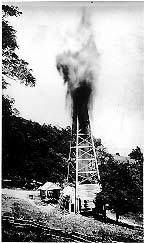The Oil and Gas Industries in West Virginia

In the early 1800's, oil and gas were of no importance to West Virginians. As a matter of fact, oil and gas were frequently hit by drillers when drilling for salt and were considered a nuisance. So much oil was diverted to the Kanawha River that it became known as "Old Greasy" to the boatmen. In 1815, while drilling for salt, gas was first struck in Charleston. By 1826, oil was used for lamps in factories and workshops.
"On the Little Kanawha River, near the Hughes River, was a stream called Burning Springs Run, named because there were two springs at its mouth from which natural gas escaped. As early as 1781, Thomas Jefferson described the brilliant flame which could be produced by thrusting a lighted candle into the escaping gas at this site. Because gas and salt brine were often associated, the Rathbone brothers bored a salt well near these springs. However, rather than salt, at a depth of 200 feet they hit petroleum and by boring deeper, they were able to produce 200 barrels per day in 1859. Although petroleum was not the treasure that the Rathbones sought, they were encouraged by their find and drilled a second well which yielded 1,200 barrels of petroleum daily. News of the Rathbone brothers' discovery spread rapidly and created tremendous excitement. By 1861, a town with several thousand inhabitants had sprung up. All of the light in the newly-formed town, including that for a brilliantly lit hotel, was provided by natural gas. The widespread use of gas in this town marked the beginning of the era of gas development in West Virginia. Meanwhile, hundreds of thousands of barrels of oil were being floated down the river to Parkersburg where they were then sent to other cities by rail or river. The Burning Springs oil field was one of only two oil fields in America prior to the Civil War. But by 1876, there were 292 wells in the State, producing a total of 900 barrels daily. Parkersburg was the chief oil market. "
(from http://www.wvgs.wvnet.edu/www/geology/geoldvog.htm)
West Virginia's oil industry reached its peak in 1900, producing 16 million barrels. The oil industry began to decline after that, although the gas industry was growing. From 1906 to 1917, West Virginia was the leading producer of gas in the United States. After that, the state's gas production declined, until 1970 when it gained momentum again.




0 Comments:
Post a Comment
Subscribe to Post Comments [Atom]
<< Home